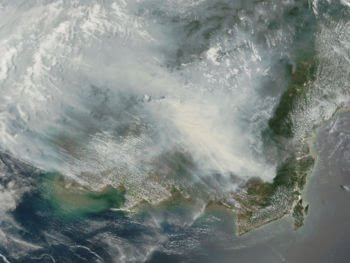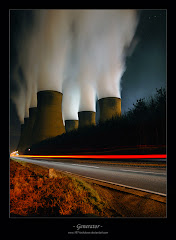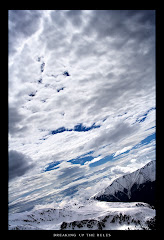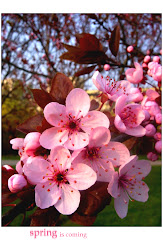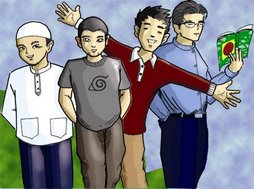The 2006
Southeast Asian haze event was caused by continued uncontrolled burning from "
slash and burn" cultivation in
Indonesia, and affected several countries in the
Southeast Asian region and beyond, such as
Malaysia,
Singapore, southern
Thailand, and as far as
Saipan[1]; the effects of the haze may have spread to
South Korea.
[2] Local sources of pollution partly contributed to the increased
toxicity, particularly in high-pollution areas such as
ports,
oil refineries, and dense urban areas. In the highly urbanised and industrialised
Klang Valley of Malaysia in particular, the surrounding terrain acted as a natural retainer of polluted air, aggravating the situation when the
haze set in. There is a link to
El Niño as well.
[3].
The haze was made worse than during previous occurrences by the
El Niño-Southern Oscillation which delayed the year's monsoon season. Fires in Kalimantan produce great amounts of smoke, burn a long time and are difficult to extinguish because they are on
peatland, and once lit the fires can burn for months and release gases that produce
sulfuric acid.
[4]Air quality across the region appeared to improve in late October as heavy rainfall doused fire in Indonesia.
[5]Countries affected
Brunei
The fires originated mostly in
Kalimantan, the Indonesian part of
Borneo, and on
Sumatra, where they are set by
swidden agriculturists employed by agroforestry concerns to clear land in order to grow pulp woods or market crops ahead of the
growing season. Satellite images taken over Borneo on
October 4 showed 561 "hot spots" indicating areas where fires had been set.
Officials in neighbouring countries accused Indonesian officials of doing nothing to stop the fires, though forestry ministry officials said they had
firefighters working to douse the
blazes on state-controlled land. However, they conceded, most of the fires were on private land.
[10] Indonesia planned to deploy its military to aid fire fighting effort.
[11] To recruit more people to man the fire line, the government offered two days off for civil servants who volunteered for fire duty.
[12] But the country lacks equipment for fighting forest fires, having airplanes that are too small to carry enough water.
[13] In a bid to obtain bigger aircraft, the government leased two
Beriev Be-200 from
Russia, which are capable of skimming over water and taking on loads for sustained firefighting efforts.
[14] The planes, which will be flown by Russians and maintained by Russian technicians, were due to begin operations on November 1.
[15]The fires have closed schools, delayed and cancelled airline flights, disrupted shipping and forced Indonesians to don
face masks. Cities affected include
Pontianak,
West Kalimantan,
Palangkaraya,
Central Kalimantan and
Pekanbaru,
Riau.
[16][17] The haze was blamed for a
Mandala Airlines flight from
Balikpapan, the provincial capital of
East Kalimantan, skidding off the runway upon landing at
Tarakan on
October 3, when visibility was reported at around 400
metres.
[18] It has caused breathing problems for people in
Riau and in
Jambi Province.
[19] On October 21, 12 airlines cancelled domestic flights from
Soekarno-Hatta International Airport due to smog at many destinations, including Jambi,
Banjarmasin,
Jayapura,
Semarang,
Surabaya,
Bengkulu,
Denpasar,
Makassar, Pekanbaru and
Padang.
[20]An October 20 report by Malaysian government news agency
BERNAMA offered a first-hand account of the scene in Kalimantan: "The suffocating smell of smoke, sore throat and eyes got worse when this reporter and a photographer stepped foot in central Kalimantan, forcing them to put on face masks. Throughout the 200-kilometre journey from Banjarmasin to Palangkaraya, what could be seen of the forests on both sides of the road was a landscape of blackish soil with smoke still billowing from the ground in some areas and of withering trees and plants. The area was foggy and dusty as the air was filled with flying ashes and other particles."
Local villagers, the report said, appeared to be unconcerned with the smog, saying it was "normal". "If we do not burn the forest, where are we going to get our food from?" a villager said.
[21]On the environmental front, fires destroyed 100
hectares of the
Tesso Nilo National Park in
Riau Province.
[22] At the
Tanjung Puting National Park in
Central Kalimantan, the haze adversely affected the
orangutans.
[22]Malaysia
The effects of the haze started in early July and affected the northern
Malaysian states severely.
[23] However, the haze had cleared substantially throughout
Peninsular Malaysia from
August 29,
2006 due to raining season. The rain reduced the number of hotspots throughout Sumatra and the Malay Peninsula. On the
August 30,
2006,
The Star reported that Kuala Lumpur would be free of haze during the
Merdeka Day. In the late evening just before midnight on
August 31,
2006, the visibility in the Klang Valley was recorded to be very good.
Unfortunately, the haze returned again in late September when Muslim Malaysians were experiencing
Ramadan. This was partly due to a change of wind direction towards the southwest, partially caused by
Typhoon Xangsane.
[24] The worst hit place was
Kuching. The Sarawak state government had declared that schools would close if the API breaches the 300 mark.
[25] The worst affected area in Peninsular Malaysia is
Johor Bahru which recorded an API of 150 on
October 7 and
October 8. For now, many people are wearing
masks to prevent themselves from inhaling excessive amounts of haze. On October 7,
visibility in parts of
East Malaysia fell to 300 metres. On or about
October 9, the worst of the haze in Peninsular seemed to be in the state of
Negeri Sembilan, where
visibility in
Sepang fell briefly to 500 metres and the
API in
Nilai reached 198, before the rain relieved the haze partially. Shortly thereafter changing winds caused conditions to improve rapidly.
Sarawak has started
cloud seeding attempts to try to encourage rainfall that will help relieve the haze.
[26] Each cloud seeding session costs at least
RM50,000 (roughly
US$14,000).
[27] On
October 21, the winds has changed direction and started to blow the hazes away from Malaysia, and the following day, heavy rain has cleared the haze. Later on
October 26, the heavy rain returned again, and there were isolated showers in
Klang Valley.
The Star reported that the hazy days are soon coming to an end as the
monsoon season is approaching.
Singapore
While the haze largely spared Singapore with 24-hour
Pollutant Standards Index readings within the "Good" range for 15 days in September and the rest in the "Moderate" range and no higher than a reading of 66
[28], its harmful effects became more prevalent in October.
On
October 7,
2006, the 3-hour PSI reading breached the 100 mark at 8 a.m. and entered unhealthy levels for the first time in the year, as winds from neighbouring
Sumatra blew the haze to Singapore
[29]. At 10 a.m., it hit 130, the highest in three years, before subsiding to 80 at 4 p.m. and climbing rapidly to 150 at 9 p.m.
[30], the worst since 1997, before ending the day at 136, still in the unhealthy range.
[31]Although the air quality was set to improve with the arrival of the
Northeast monsoon rains in mid-October, southeasterly winds extended the hazy season.
[32] A mild
El Niño effect delayed the starting of the showers to late October or early November,
[22] or even until the end of November. The prolonged haze could be attributed to the extended dry season, which put the rains on hold and affected wind patterns which brought the haze to Singapore. Intermittent showers could occur in the pre-monsoon period, but these would do little in increasing air quality. The unpredictable winds in the pre-monsoon period could bring haze from either Sumatra or Kalimantan.
[33]Air quality remained in the moderate range for the next week
[28] until
October 14, when the 3-hour PSI readings gradually increased from 53 at 6 a.m. to peak at an unhealthy 116 at 10 p.m.
[34]This time, majority of the haze came from
Kalimantan[35].
Similarly, on
October 15, the PSI readings increased from 69 at 6 a.m. to 98 at 3 p.m. and 4 p.m.
[36], 3 points short of reaching the unhealthy range. This eased to 82 by midnight.
[37] As winds remained southeasterly, haze from Kalimantan blew across the
South China Sea to Singapore.
[38]The next day, on
October 16, the PSI stayed in the 80s in the morning, before shooting up once again into the unhealthy range, hitting a high of 130 at 4 p.m. and 5 p.m. The 3-hour PSI remained in unhealthy levels for 8 consecutive hours, between 2 p.m. and 9 p.m.
[39] The haze obscured the sun, and symptoms of exposure to haze resurfaced in the general population.
[40] The 24-hour PSI for October 16 reached 98,
[28] just 3 points short of unhealthy. Visibility dropped to as low as 1
km in some areas, compared to the usual 20 km.
[39]The PSI on
October 17 gradually increased from the moderate range in the morning to slip into the unhealthy range at 4 p.m., reaching 106,
[41] before declining back to 100 in the moderate range at 10 p.m.
[42] The hazy conditions were expected to persist.
[41]On
October 19, the PSI crept into the unhealthy range at 106 at 2 p.m.
[43], peaking at 113 at 4 p.m. The National Environment Agency reported that the situation would not improve the next day.
[44]Throughout the early morning on
October 20, the PSI kept in the 90s, before reaching a high of 103 at 8 a.m.
[33] This dropped to 74 by 7 p.m., although the PSI remained in the 90s in the afternoon.
[45] Even though rain fell in some areas, this was not enough to "alleviate the haze situation". The NEA forecasted thunderstorms over the weekend, but the southeasterly winds would continue to prevail.
[46] The 24-hour PSI on October 20 also reached the unhealthy range at 102.
[28]Later in
October, though, the situation began to improve, with the PSI hitting a low of 11 at 2 p.m. on
October 26.
However, in early
November, intermonsoonal winds brought slight haze back to Singapore, with the 3-hour PSI in the moderate range most of the time.
The highest 3-hour average PSI ever recorded was 226 in September 1997.
[47]Impact
While some Singaporeans began donning face masks, others frequented shopping malls and public places like
VivoCity, with many shopping before
Deepavali at
Little India,
[48] and going to
Geylang Serai's annual
Hari Raya bazaar. Stallholders said that the haze had not affected their business.
[49] However, Singaporeans generally kept indoors,
[37] with some staying away from
East Coast Park.
[48]The government announced plans for a haze action plan if the situation became "extremely dangerous", which included priority treatment for haze-related illnesses.
[50] Health Minister
Khaw Boon Wan said that there was "very little that (could) be done to stop the haze", and advised people to remain indoors, especially those with prior respiratory conditions.
[51]Some minor haze-related illness began to surface, but free clinics across the island did not report any increase in patients with this symptoms.
[34] However, attendance figures at
Polyclinics islandwide increased by 600 cases to about 15,000 cases of haze-related conditions in the first week of October as compared to the same period last month.
[50] This is despite the
National Healthcare Group reporting that the number of people "complaining of the same ailments" has decreased from the same period last year.
[52]Air purifier sales shot up during the hazy period.
Best Denki, an electronic store, sold
S$350,000 worth of air purifiers and related items in 4 days, a 300 percent increase. However, experts from the
Institute of Environmental Science & Engineering at the
Nanyang Technological University said that only some of these products, like High Efficiency Particulate
air filters, would effectively remove small particles from air. Other kinds of air purifiers like
ionizing purifiers gave off
ozone which could cause symptoms similar to those caused by the haze. The experts recommended regularly cleaning the filter media and opening windows to get some fresh air at night.
[53]The
western region, which includes
Boon Lay,
Choa Chu Kang and
Jurong, seemed to be the "
epicentre" of the haze. Residents there complained of the worse conditions in their area, saying that it felt "hotter than usual", and health problems were more widespread. The air quality levels in the west have consistently been the worst, but only by several points. Some speculated that the more polluted air was caused by the many
construction sites and
industrial parks in Jurong and
Tuas, but NEA refuted this, claiming that they did not contribute to the haze. Polyclinics in Jurong and
Bukit Batok have an increase of 20 percent for patients with respiratory problems and
asthma.
[52]Schools islandwide restricted outdoor activities and had to rethink post-examination activities and training or revert to wet-weather programmes. The
Singapore Sports School's swim team had to cut back on training when the haze reached unhealthy levels even though they were in the midst of various international competitions.
[54] The
Ministry of Education recommended that schools suspend all outdoor activities when the PSI reading passes 100, but some schools chose to move indoors regardless of the PSI.
[55]Many Singaporean "fitness buffs" have also made the move indoors.
Fitness clubs reported increases in turn-outs and check-ins, utilizing
gym facilities rather than outdoor activities.
Rock climbers were also affected, and began to move activities indoors instead.
[56]The haze has also caused increased sales and rental of entertainment
VCD and
DVD titles, but cinema attendance is unchanged.
[57]The National Environment Agency website received about 170,000 hits on October 14, as compared to the usual 60,000, and caused the server to temporary go down due to the sheer volume of traffic.
[22]According to economists, Singapore has suffered a
US$50 million economic loss due to this year's onset of haze.
[58]Thailand
In July, the southern
Thai provinces of
Pattani and
Satun suffered an on-and-off bout of
smog, with the levels of pollutants in Satun being high enough to constitute a health hazard.
[59] In all, seven provinces were affected by the haze in July and August.
Haze was again reported on October 6, with respiratory illnesses and eye irritation reported in
Narathiwat.
[60] Visibility and air quality were also affected in
Songkhla, Satun and
Yala. Health warnings were issued and
surgical masks were issued to residents. Three days later, meteorological officials reported that the haze had thinned to almost normal visibility.
[61]Strong winds in the region brought haze from Indonesia back into Songkhla, Satun, Pattani, Yala and Narathiwat provinces on
October 17. Visibility in Yala and Songkhla was reduced to less than a kilometre, and officials warned fishermen going out to the
Andaman Sea and
Gulf of Thailand to "stay vigilant". Drivers were also asked to turn on their headlights.
[62]
ASEAN Ministerial Meeting on Transboundary Haze Pollution
Malaysia and Singapore criticized the way Indonesia handled the issue. Both urged the latter to ratify the
ASEAN Agreement on Transboundary Haze Pollution. The Malaysian Environment Minister
Azmi Khalid said "Frustration is an understatement", directed toward Indonesia.
[63]. There was also a protest in front of the Indonesia embassy in Kuala Lumpur, organized by local political parties.
[64] Singaporean Prime Minister Lee Hsien Loong expressed disappointment toward Indonesia soon after Azmi Khalid made his view public.
[65] In response to the letter, Indonesian President apologized for the regional haze.
[66] Indonesia has earlier stated that it lacked the resources to combat the burning effectively.
[67]Singapore proposed regional talks on the haze, to be held in Singapore. Indonesia, however, requested such talks to be held in
Pekan Baru,
Kalimantan instead.
[68] The request was agreed to and talks were held on October 13 2006. At the meeting, Malaysia proposed the setting up of a regional fund to help combat the environmental disaster.
[69]With the arrival of the northeastern winter
monsoons in December, the haze problem was effectively ended for
2006.



 There are several main types of pollution and well-known effects of pollution which are commonly discussed. These include smog, acid rain, the greenhouse effect, and "holes" in the ozone layer. Each of these problems has serious implications for our
There are several main types of pollution and well-known effects of pollution which are commonly discussed. These include smog, acid rain, the greenhouse effect, and "holes" in the ozone layer. Each of these problems has serious implications for our 